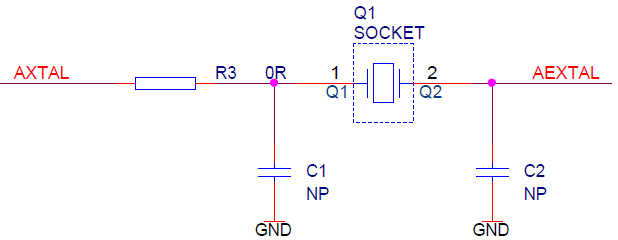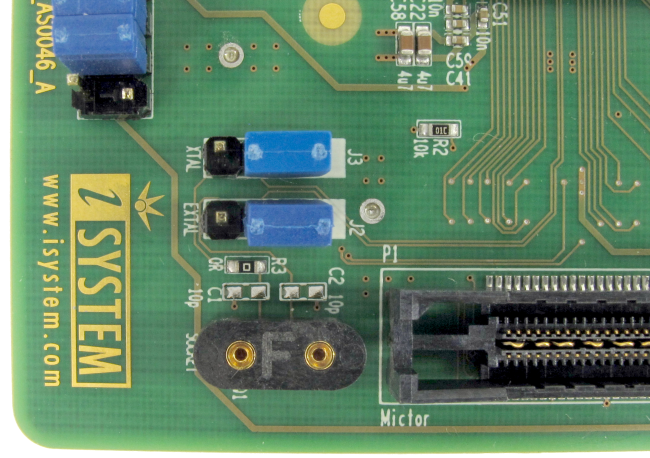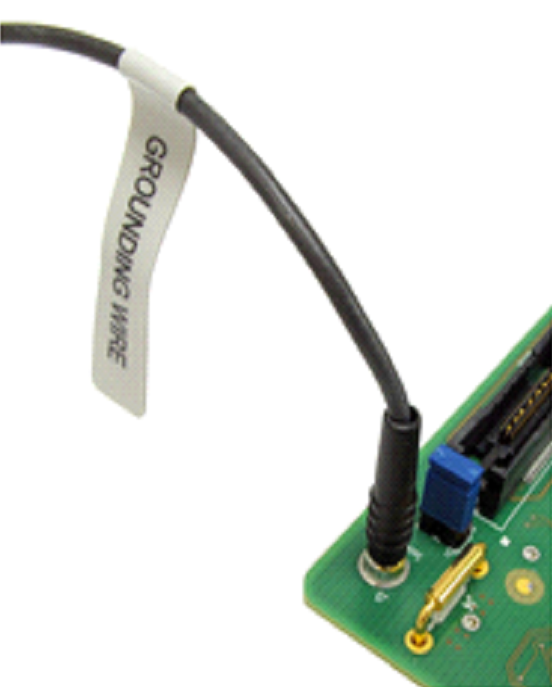Configuration
In this topic:
•J2 and J3: Clock source configuration
•J4 and J5: GND connecting points
•P2: Power supply configuration
|
For a detailed visual presentation of the hardware setup and configuration, refer to: |
J1: Target reset configuration
Jumper J1 connects the SPC58EC80 reset line and the target reset line. By default, J1 is populated.
When having problems establishing the initial debug session with the emulation adapter, try to remove J1 and see if it makes any difference.
J2 and J3: Clock source configuration

Jumpers J2 and J3 select the clock source for the emulation device. The Emulation Adapter is delivered with J2 and J3 set in the default position 1-2, closer to Pin 1 marking.
Position 1-2 (default) selects the crystal circuit oscillator on the target board. To select the crystal circuit oscillator on the Emulation Adapter (Q1 socket), set:
1. Set both Jumpers J2 and J3 away from Pin 1 marking.
2. Insert the crystal circuit delivered with the Emulation Adapter into the Q1 socket.
|
The Emulation Adapter may not operate when the target board’s crystal circuit is used as the clock source. A typical design guideline is that the crystal should be as close as possible to the SoC. The target crystal might not oscillate in conjunction with the Emulation Adapter since the clock lines between the target crystal and the emulation device on the Emulation Adapter become too long, thus affecting the impedance of the crystal circuit. |
|
The separately packed 20 MHz crystal* can be used as a 20 MHz external clock (XOSC) source to the emulation device. If a different clock frequency is required, insert appropriate crystal into the Q1 socket. Crystal socket Q1 is by default not populated (NP). |
* Emulation Adapters of revision A4 or lower were delivered with a 40 MHz crystal.
Crystal Q1 is located in the corner of the Emulation Adapter, next to the 38-pin Mictor connector P1 and per default not populated:


Capacitors C1 and C2, for which pads are provided on the emulation adapter PCB, are not populated since the microcontroller provides already the internal load capacitors for 20 MHz / 40 MHz crystal oscillator operation.
0 ohm resistor is populated in place of the serial R3 resistor.
|
Emulation adapters of revision A2 or lower had capacitors C1 and C2 populated with 10p. |
J4 and J5: GND connecting points

Real target microcontroller in the QFP package provides an exposed GND pad in the middle of the microcontroller at the bottom side of the package. This provides GND connection between the microcontroller and the target.
In case of the Emulation Adapter usage, the solder part is soldered instead of the microcontroller. Note that the available solder parts at the introduction of this Emulation Adapter, did not provide support for the exposed GND pad.
Ensure that replacement GND connection between the Emulation Adapter and the target using a dedicated GND wire. Without this connection, the system will not work. Use provided GND wire which comes along the Emulation Adapter and plug it to the pin J5 (see picture above) on the Emulation Adapter. Connect the other side to the ground potential on the target - as close as possible to the microcontroller respectively solder part being soldered instead of the microcontroller. This connection must be quality and reliable otherwise debugging and tracing over the Nexus trace port may not work. Alternatively, GND connection can be also established over the J4 ground bridge.
P2: Power supply configuration
Emulation Adapter Power supply is configured via the unshrouded 26-pin 2.54 mm header (P2).
Signal direction |
Signal |
Pin |
Pin |
Signal |
Signal direction |
|---|---|---|---|---|---|
Not connected |
NC |
1 |
2 |
NC |
Not connected |
Target |
VDD_HV_OSC |
3 |
4 |
CVDD_HV_OSC |
Emulation device |
Target |
VDD_HV_ADV_S |
5 |
6 |
CVDD_HV_ADV_S |
Emulation device |
Target |
VDD_HV_ADR_C |
7 |
8 |
CVDD_HV_ADR_C |
Emulation device |
Target |
VDD_HV_IO_MAIN |
9 |
10 |
CVDD_HV_IO_MAIN |
Emulation device |
Target |
VDD_HV_FLA |
11 |
12 |
CVDD_HV_FLA |
Emulation device |
Target |
VDD_HV_IO_FLEX |
13 |
14 |
CVDD_HV_IO_FLEX |
Emulation device |
Not connected |
NC |
15 |
16 |
NC |
Not connected |
Not connected |
NC |
17 |
18 |
NC |
Not connected |
Not connected |
NC |
19 |
20 |
NC |
Not connected |
Ground |
GND |
21 |
22 |
GND |
Ground |
Ground |
GND |
23 |
24 |
GND |
Ground |
Ground |
GND |
25 |
26 |
KEY |
|
P2 Signal description
Refer to the microcontroller user’s manual for more details which power supply designation in the above table belongs to which power supply.
By default, all jumpers are set and connect target power supply coming from the target to the microcontroller residing on the Emulation Adapter. In principle, pins 3-4, 5-6, 7-8, 9-10, 11-12 and 13-14 must be bridged only but for the convenience and ease of use all jumpers are set, except for pins 25-26. Pin 26 is the polarizer key preventing incorrect connection of the IEA-PS power supply, when being connected.
If a different power source is to be used (e.g., in case of a standalone operation), all jumpers must be removed and power source must be applied to:
•CVDD_HV_OSC (pin 4), •CVDD_HV_ADV (pin 6), •CVDD_HV_ADR_S (pin 8), •CVDD_HV_IO_MAIN (pin 10), |
•CVDD_HV_FLA (pin 12), •CVDD_HV_IO_FLEX (pin 14), •GND (pins 22, 24, 26) signals.
|
The EA comes delivered together with the IEA-PS emulation adapter power supply, which simply plugs into the P2 header row, providing the necessary power supply for Emulation Adapter standalone operation. Double check that the power supply is configured properly for this particular Emulation Adapter.
